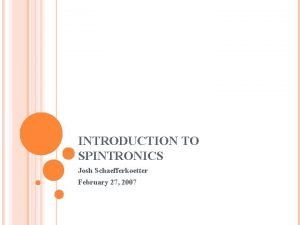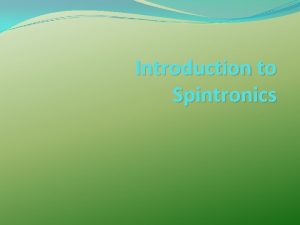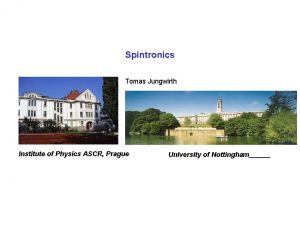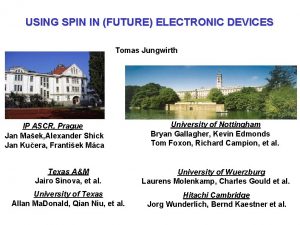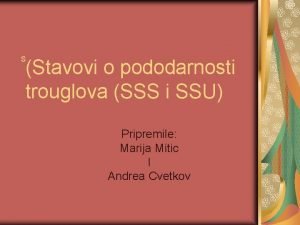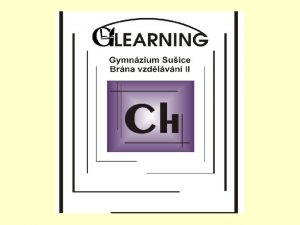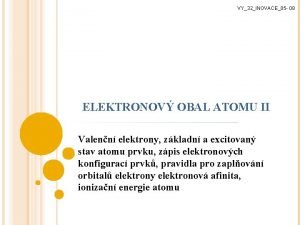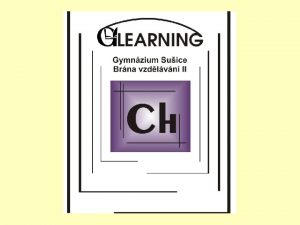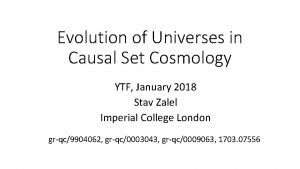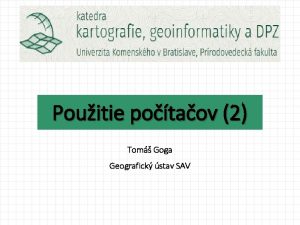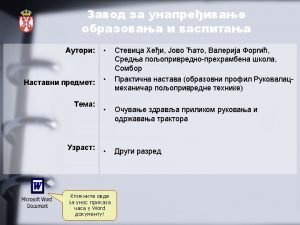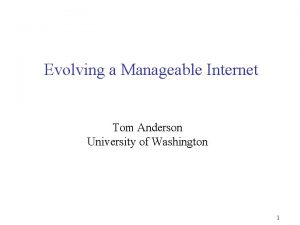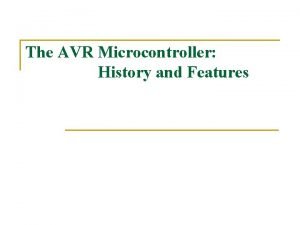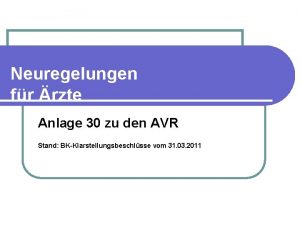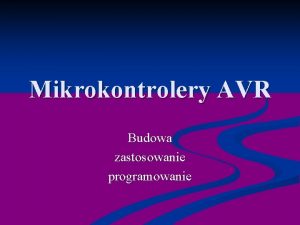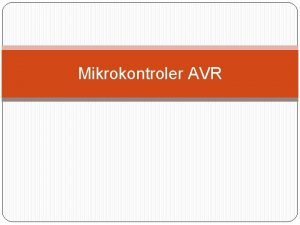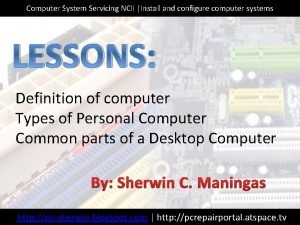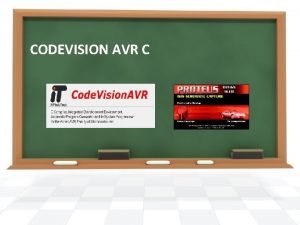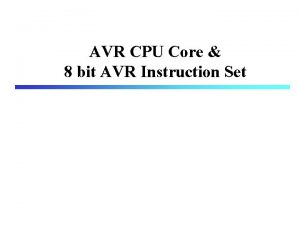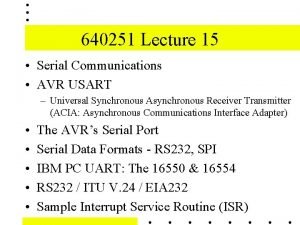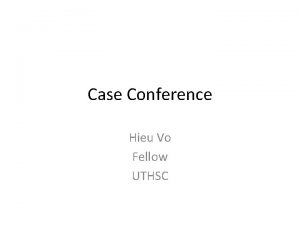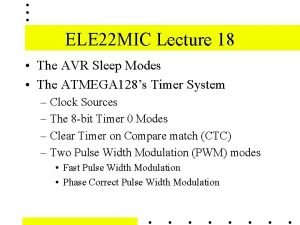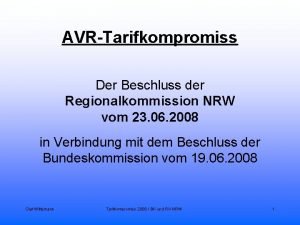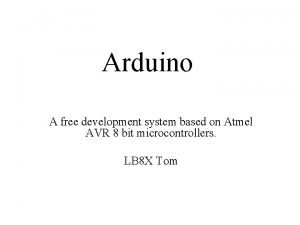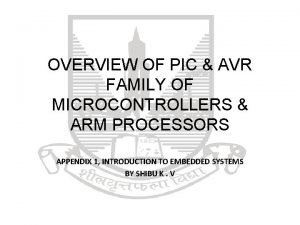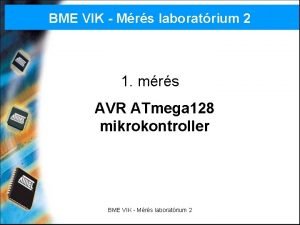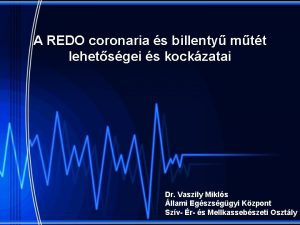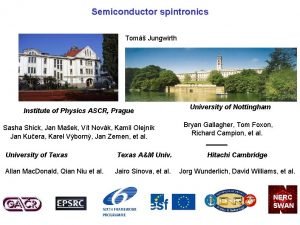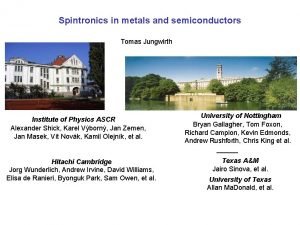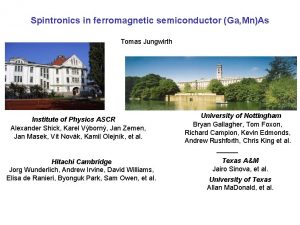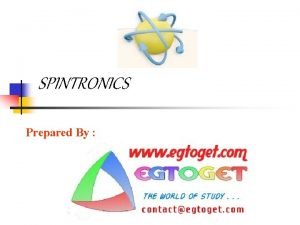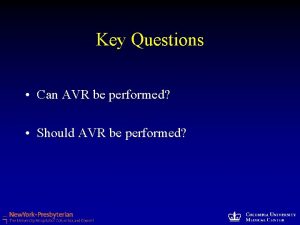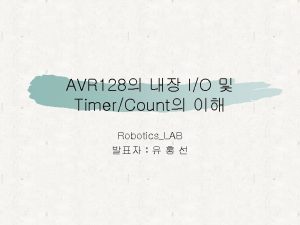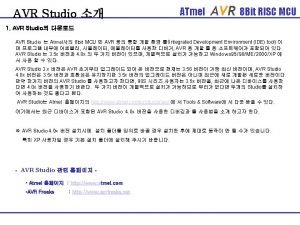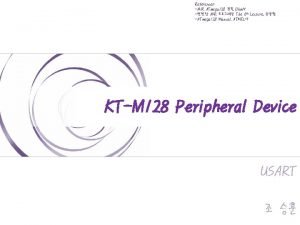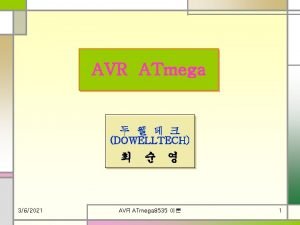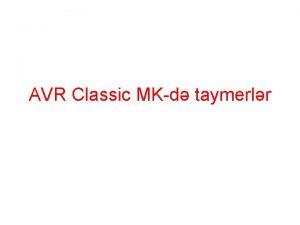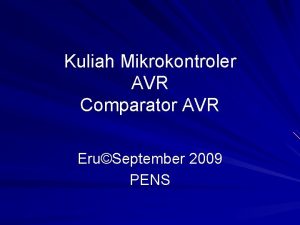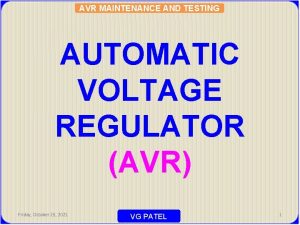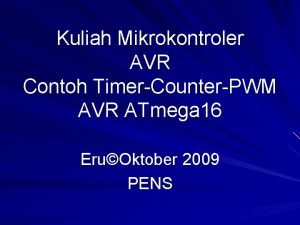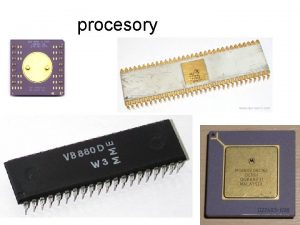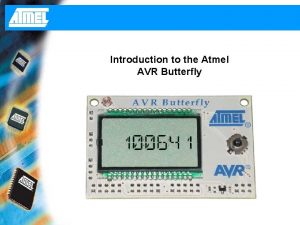SPINTRONICS Tom Jungwirth Fyzikln stav AVR University of















































- Slides: 47

SPINTRONICS Tomáš Jungwirth Fyzikální ústav AVČR University of Nottingham

1. Current spintronics in HDD read-heads and memory chips 2. Physical principles of operation of current spintronic devices 3. Research at the frontiers of spintronics 4. Summary

Current spintronics applications First hard disc (1956) - classical electronics for read-out 1 bit: 1 mm x 1 mm MByte From PC hard drives ('90) to micro-discs - spintronic read-heads GByte 1 bit: 10 -3 mm x 10 -3 mm

HARD DISKS

HARD DISK DRIVE READ HEADS spintronic read heads horse-shoe read/write heads

Anisotropic magnetoresistance (AMR) read head 1992 - dawn of spintronics Appreciable sensitivity, simple design, scalable, cheap

Giant magnetoresistance (GMR) read head 1997 High sensitivity

. MEMORY CHIPS DRAM (capacitor) - high density, cheep x slow, high power, volatile . SRAM (transistors) - low power, fast x low density, expensive, volatile . Flash (floating gate) - non-volatile x slow, limited life, expensive Operation through electron charge manipulation

MRAM – universal memory fast, small, non-volatile First commercial 4 Mb MRAM Tunneling magneto-resistance effect (TMR) RAM chip that won't forget ↓ instant on-and-off computers


MRAM – universal memory fast, small, non-volatile First commercial 4 Mb MRAM Tunneling magneto-resistance effect (TMR) RAM chip that won't forget ↓ instant on-and-off computers

1. Current spintronics in HDD read-heads and memory chips 2. Physical principles of current spintronic devices operation 3. Research at the frontiers of spintronics 4. Summary

Electron has a charge (electronics) and spin (spintronics) Electrons do not actually “spin”, they produce a magnetic moment that is equivalent to an electron spinning clockwise or anti-clockwise

quantum mechanics & special relativity particles/antiparticles & spin E=p 2/2 m E ih d/dt p -ih d/dr. . . E 2/c 2=p 2+m 2 c 2 (E=mc 2 for p=0) high-energy physics Dirac eq. solid-state physics and microelectronics

Resistor classical spintronic external manipulation of charge & spin internal communication between charge & spin e-

Non-relativistic (except for the spin) many-body e- Pauli exclusion principle & Coulomb repulsion Ferromagnetism total wf antisymmetric FERO = orbital wf antisymmetric * spin wf symmetric (aligned) MAG • Robust (can be as strong as bonding in solids) • Strong coupling to magnetic field (weak fields = anisotropy fields needed only to reorient macroscopic moment) NET

Relativistic "single-particle" Spin-orbit coupling (Dirac eq. in external field V(r) & 2 nd-order in v /c around non-relativistic limit) Ingredients: - potential V(r) E - motion of an electron e- Produces an electric field In the rest frame of an electron the electric field generates and effective magnetic field - gives an effective interaction with the electron’s magnetic moment • Current sensitive to magnetization direction V Beff s p

e- Spintronics Ferromagnetism Coulomb repulsion & Pauli exclusion principle Spin-orbit coupling Dirac eq. in external field V(r) & 2 nd-order in v /c around non-relativistic limit V s p Beff Fermi surfaces ky ~Mx. sx FM without SO-coupling kx ~(k. s)2 SO-coupling without FM ~(k. s)2 + Mx. sx FM & SO-coupling

Fermi surfaces ky kx FM without SO-coupling ~(k. FM & SO-coupling without FM AMR M kx k SO-coupling: anisotropies in Ohmic transport characteristics; ~1 -10% MR sensor scattering y Ferromagnetism: sensitivity to magnetic field M kx ky ~Mx. sx ~(k. s)2 + Mx. sx s)2 hot spots for scattering of states moving M R(M I)> R(M || I)

Diode classical spin-valve TMR Based on ferromagnetism only; ~100% MR sensor or memory no (few) spin-up DOS available at EF large spin-up DOS available at EF

1. Current spintronics in HDD read-heads and memory chips 2. Physical principles of current spintronic devices operation 3. Research at the frontiers of spintronics 4. Summary

Removing external magnetic fields (down-scaling problem)

EXTERNAL MAGNETIC FIELD problems with integration - extra wires, addressing neighboring bits

Current (instead of magnetic field) induced switching Angular momentum conservation spin-torque

magnetic field current Myers et al. , Science '99; PRL '02 local, reliable, but fairly large currents needed Likely the future of MRAMs

Spintronics in the footsteps of classical electronics from resistors and diodes to transistors

AMR based diode - TAMR sensor/memory elemets TAMR TMR no need for exchange biasing or spin Au coherent tunneling FM AFM Simpler design without exchange-biasing the fixed magnet contact

Spintronic transistor based on AMR type of effect Huge, gatable, and hysteretic MR Single-electron transistor Two "gates": electric and magnetic

Spintronic transistor based on CBAMR Source Q VD Drain Q 0 Gate VG e 2/2 C [110] [010] M F [100] [110] electric & magnetic control of Coulomb blockade oscillations [010] SO-coupling (M)

CBAMR SET • Generic effect in FMs with SO-coupling • Combines electrical transistor action with magnetic storage • Switching between p-type and n-type transistor by M programmable logic In principle feasible but difficult to realize at room temperature

Spintronics in the footsteps of classical electronics from metals to semiconductors

Spin FET – spin injection from ferromagnet & SO coupling in semiconductor V Beff Difficulties with injecting spin polarized currents from metal ferromagnets to semiconductors, with spincoherence, etc. not yet realized s p

Ferromagnetic semiconductors – all semiconductor spintronics More tricky than just hammering an iron nail in a silicon wafer Ga Mn As Ga. As - standard semiconductor Mn Mn - dilute magnetic element (Ga, Mn)As - ferromagnetic semiconductor

Ga (Ga, Mn)As (and other III-Mn-V) ferromagnetic semiconductor • compatible with conventional III-V semiconductors (Ga. As) • dilute moment system e. g. , low currents needed for writing • Mn-Mn coupling mediated by spin-polarized delocalized holes spintronics • tunability of magnetic properties as in the more conventional semiconductor electronic properties. • strong spin-orbit coupling magnetic and magnetotransport anisotropies • Mn-doping (group II for III substitution) limited to ~10% • p-type doping only • maximum Curie temperature below 200 K Mn As Mn

(Ga, Mn)As material Ga Mn As Mn - Mn local moments too dilute (near-neghbors cople AF) - Holes do not polarize in pure Ga. As - Hole mediated Mn-Mn FM coupling 5 d-electrons with L=0 S=5/2 local moment moderately shallow acceptor (110 me. V) hole

Mn–hole spin-spin interaction Ga Mn As-p Mn-d hybridization Hybridization like-spin level repulsion Jpd SMn shole interaction

Ferromagnetic Mn-Mn coupling mediated by holes heff = Jpd <SMn> || x Hole Fermi surfaces Mn As Ga Heff = Jpd <shole> || -x

No apparent physical barriers for achieving room Tc in III-Mn-V or related functional dilute moment ferromagnetic semiconductors Need to combine detailed understanding of physics and technology Weak hybrid. Delocalized holes long-range coupl. In. Sb, In. As, Ga. As d 5 Strong hybrid. Ga. P Impurity-band holes short-range coupl.

And look into related semiconductor host families like e. g. I-II-V’s III = I + II Ga = Li + Zn Ga. As and Li. Zn. As are twin SC (Ga, Mn)As and Li(Zn, Mn)As should be twin ferromagnetic SC But Mn isovalent in Li(Zn, Mn)As no Mn concentration limit possibly both p-type and n-type ferromagnetic SC

Spintronics in non-magnetic semiconductors way around the problem of Tc in ferromagnetic semiconductors & back to exploring spintronics fundamentals

Spintronics relies on extraordinary magnetoresistance Ordinary magnetoresistance: response in normal metals to external magnetic field via classical Lorentz force B Extraordinary magnetoresistance: response to internal spin polarization in ferromagnets often via quantum-relativistic spin-orbit coupling anisotropic magnetoresistance _ _ _ FL +++++++ V I M __ FSO I e. g. ordinary (quantum) Hall effect V and anomalous Hall effect Known for more than 100 years but still controversial

Anomalous Hall effect in ferromagnetic conductors: spin-dependent deflection & more spin-ups transverse voltage skew scattering intrinsic _ __ FSO minority V side jump majority I _ FSO __ FSO non-magnetic I V=0 Spin Hall effect in non-magnetic conductors: spin-dependent deflection transverse edge spin polarization

Spin Hall effect detected optically in Ga. As-based structures Same magnetization achieved by external field generated by a superconducting magnet with 106 x larger dimensions & 106 x larger currents p n n SHE mikročip, 100 A SHE detected elecrically in metals Cu supravodivý magnet, 100 A SHE edge spin accumulation can be extracted and moved further into the circuit

1. Current spintronics in HDD read-heads and memory chips 2. Physical principles of current spintronic devices operation 3. Research at the frontiers of spintronics 4. Summary

Downscaling approach about to expire currently ~ 30 nm feature size interatomic distance in ~20 years Spintronics: from straighforward downscaling to more "intelligent" device concepts: • simpler more efficient realization for a given functionality (AMR sensor) • multifunctional (integrated reading, writing, and processing) • new materials (ferromagnetic semiconductors) • fundamental understanding of quantum-relativistic electron transport (extraordinary MR)

Anisotropic magneto-resistance sensor Electromagnet • Information reading Ferr o Magnetization Current • Information reading & storage Tunneling magneto-resistance sensor and memory bit • Information reading & storage & writing Current induced magnetization rotation

• Information reading & storage & writing & processing Spintronic single-electron transistor: magnetoresistance controlled by gate voltage • New materials Ga As Dilute moment ferromagnetic semiconductors Mn • Spintronics fundamentals AMR, anomalous and spin Hall effects Mn
 Introduction to spintronics
Introduction to spintronics Introduction to spintronics
Introduction to spintronics Institute of physics ascr
Institute of physics ascr Tomas jungwirth
Tomas jungwirth Tomas jungwirth
Tomas jungwirth Sta znaci sss
Sta znaci sss Excitovaný stav příklady
Excitovaný stav příklady Orbitaly řada
Orbitaly řada šídlo
šídlo Excitovaný stav dusíku
Excitovaný stav dusíku Rovnovážný stav soustavy
Rovnovážný stav soustavy Cosmology
Cosmology Stav sav
Stav sav Stav sav
Stav sav Stav ni cleni
Stav ni cleni Poasie
Poasie Spetni stav
Spetni stav Tom tom go 910
Tom tom go 910 What does the bible symbolize in the devil and tom walker
What does the bible symbolize in the devil and tom walker Tom anderson university of washington
Tom anderson university of washington Tom anderson university of washington
Tom anderson university of washington Vrste rashoda
Vrste rashoda Features of avr
Features of avr Avr anlage 30 entgelttabelle
Avr anlage 30 entgelttabelle Rufbereitschaft avr anlage 33
Rufbereitschaft avr anlage 33 Bascom 8051
Bascom 8051 Avr architecture
Avr architecture Bpa lohntabelle 2021 sachsen anhalt
Bpa lohntabelle 2021 sachsen anhalt Installing and configure computer systems
Installing and configure computer systems Code vision avr
Code vision avr Iom328p.h
Iom328p.h Avr instruction set
Avr instruction set Arsitektur produk
Arsitektur produk Avr usart interrupt example
Avr usart interrupt example Avr simulator
Avr simulator Codevision wizard
Codevision wizard Pitting edema
Pitting edema Atmega sleep mode
Atmega sleep mode Avr caritas ehegattenbezogene besitzstandszulage
Avr caritas ehegattenbezogene besitzstandszulage Atmega128 타이머/카운터 예제
Atmega128 타이머/카운터 예제 Arduino uno
Arduino uno Pic vs avr
Pic vs avr Archetypes of villains
Archetypes of villains A0ldi
A0ldi Avr vs arm
Avr vs arm Mega128.h
Mega128.h Resternotomia
Resternotomia Atmel avr instruction set
Atmel avr instruction set
